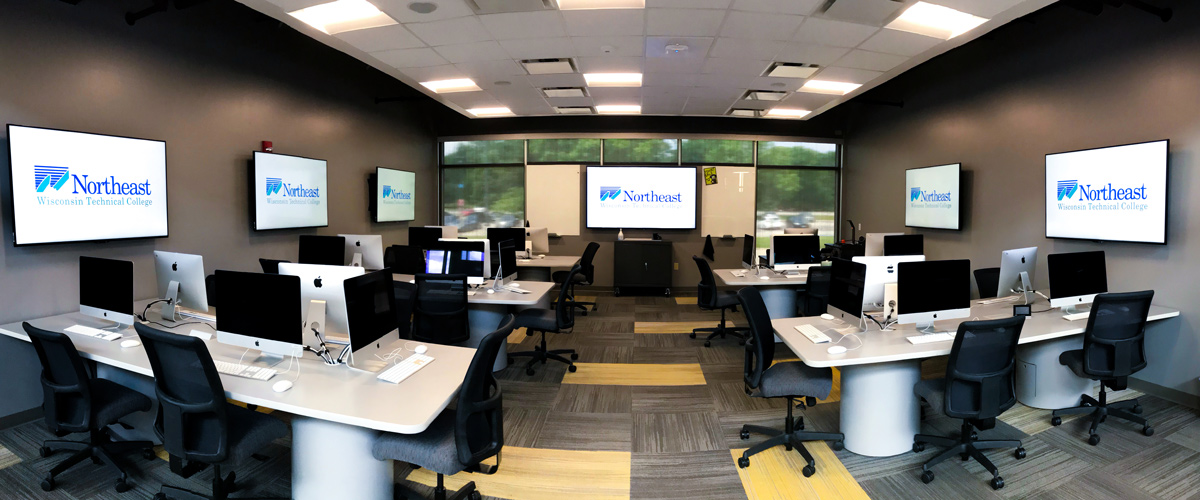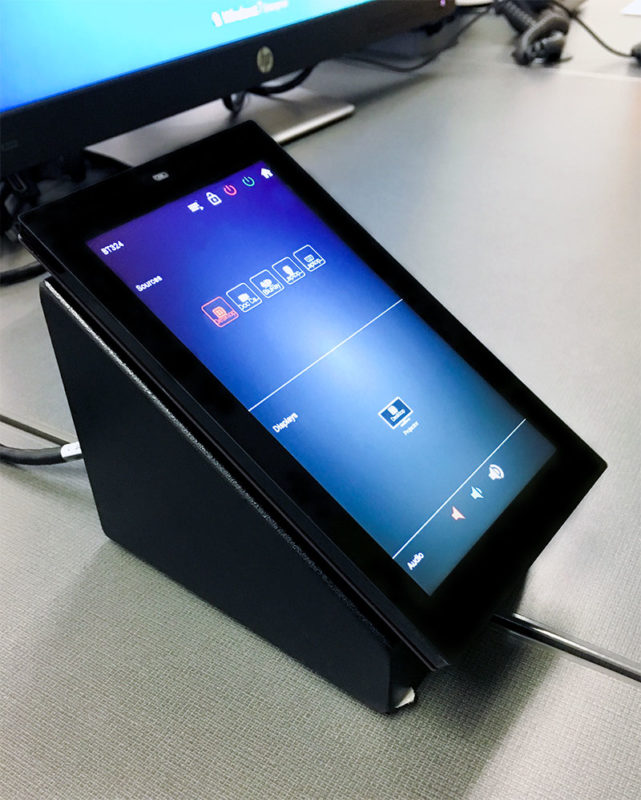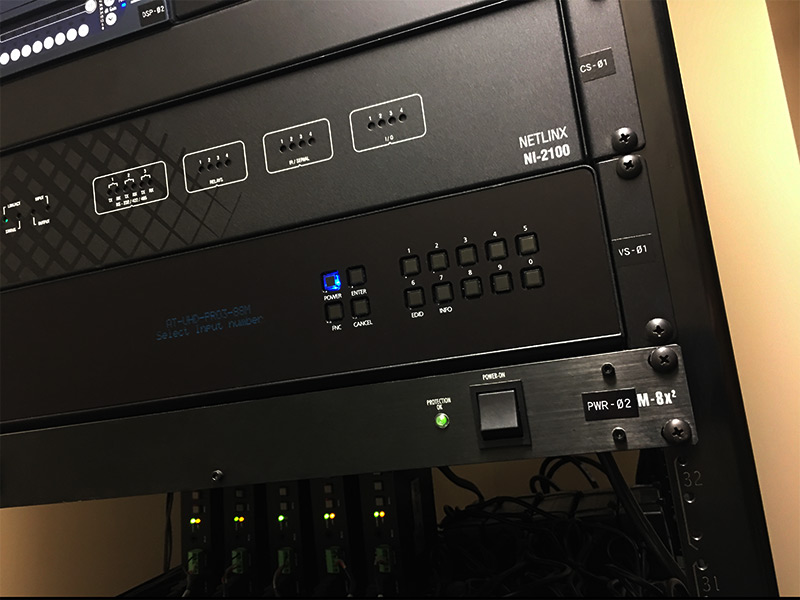
Case Study: Northeast Wisconsin Technical College
Enhances Active Learning Spaces
Download the Case Study PDFAtlona presentation switchers and networked AV control represent a paradigm shift in collaboration
Founded in 1912, Northeast Wisconsin Technical College (NTWC) is a nationally-ranked, two-year public college where students prepare for high-tech careers and begin their bachelor’s degrees. Continually expanding and enhancing its facilities to support high-demand industry sectors, the college depends on flexible and intuitive AV technology to realize the full collaborative potential of its active learning environments.
When the college recently embarked on a three-year technology upgrade plan spanning three campuses, five regional learning centers and four “specialty centers”, it put its trust in Appleton, Wisconsin-based audio-visual integrator Arrow AV Group to recommend forward-looking solutions. Working together, the NTWC and Arrow AV teams first set its sights on the Business Technology division, with a plan to roll out 20 “smart classrooms” and “10 active classrooms” as phase one.

“We now use Atlona for every classroom build.”
– Jonathan Tipler, Instructional Technology Technician
“The BT division uses a lot of video and audio for instructional purposes, both for learning and for support needs such as content editing,” says NWTC instructional technology technician Jonathan Tipler. “The AV requirements are therefore a lot more intense than in other divisions. That made this the right place to start.
Both the smart and active classrooms include similar AV technology architectures, though the learning environments are quite different. The Smart Classrooms are more general layouts with a single instructor station and scattered tables for students, without PC or Mac workstations. The active classrooms are designed specifically for classes where students need to engage in shared content via computers.

“Velocity is straightforward to set up, which means that you don’t need to be a programmer. I also realized the benefit of being able to remote in from my phone and initiate rooms prior to the start of a class.”
– Tipler
With these classroom blueprints in mind, NWTC and the Arrow AV team set out to find technologies that could be applied across both rooms for switching, distribution and presentation.
“Our first goal was to replace all of our legacy gear, as we wanted to upgrade our rooms while meeting specific instructive needs,” says NWTC instructional technology technician Jonathan Tipler, who himself spent seven years as an AV installer prior to joining the college. “Arrow recommended Atlona products to replace our previous vendor, and we now use Atlona for every classroom build.”
“NWTC looks to us for advice on meeting their desires and requirements,” confirms Curt Maas, president of Arrow AV Group. “Our objective is to meld their needs with the technology that’s currently available and come up with solutions that meet all of their criteria. We have introduced most of our higher education clients to Atlona products, as we found them to be very reliable at a better price point than most alternatives, and with a better warranty than all of their competitors.”
While Arrow AV’s intensive research was instrumental for decisions around switching and distribution gear, Tipler and his team also made discoveries of their own on the control side that would lead them directly to Atlona’s groundbreaking networked AV control platform, Velocity.

“Atlona has become a good partner with us, and its ten-year warranty makes it very easy for ourselves and our customers.”
–Curt Maas, president of Arrow AV Group
From Smart Classrooms to Study Spaces
In NWTC’s basic smart classrooms, Atlona AT-UHD-CLSO-601 six-input, multi-format switchers route HDMI and VGA video inputs to a single projector. The same model also forms the AV heart of the school’s active, or “pod”, classrooms, where they are combined with additional Atlona products in flexible signal distribution architectures.
“Our pod classrooms utilize the CLSO-601 in exactly the same manner as our basic classrooms, but we send its HDMI output to an AT-UHD-CAT-8 HDMI-to-HDBaseT™ distribution amplifier to disperse the instructor’s content to anywhere from three to six learning pods per room,” explains Tipler.“Many of our active classrooms are also computer labs, with five computers at each pod. An Atlona AT-UHD-SW-51 five-input HDMI switcher at each table lets students select which of those local computers to display on the pod monitor. And some of our hybrid rooms combine them, using an AT-UHD-PRO3-88M or AT-UHD-PRO3-66M HDMI to HDBaseT matrix switcher.”
Tipler touts the CLSO-601’s HDBaseT output as streamlining connectivity, while its VGA inputs provide source flexibility. “We try to push HDBaseT here, as it minimizes wiring and simplifies installation and support,” he says. “The Panasonic projectors we use in our classrooms have DIGITAL LINK inputs – Panasonic’s connection system based on HDBaseT – so we can take advantage of the HDBaseT output with a single line carrying video and control.
“We’re also pushing to remove VGA from most of our systems, if not all of them, but it’s a slow process phasing VGA out,” he continues. “The dual VGA inputs on the CLSO-601 help us make that transition from analog to digital.”
NWTC also relies on Atlona in study spaces and one-on-one rooms. “AT-HD-SC-500 three-by-one switchers are in all of our huddle spaces,” Tipler notes. “We chose them for their automatic input switching. When students turn on the TV, the local PC is always there as the default input. They can plug their laptop into wall-mounted HDMI or VGA ports, and the switcher will automatically adjust for that input. The students benefit from the auto-switching because they’re always seeing a source – never a ‘no signal’ error – and our department benefits from fewer AV support calls in those rooms.”
As important as automated control capabilities are to NWTC, Tipler also points to the CLSO-601’s front-panel buttons as very beneficial. “They give us a manual option to switch between inputs, if required,” he notes.
Taking Control
The move to Atlona from the previous vendor’s legacy equipment has also brought significant control benefits to NWTC, thanks to the Atlona’s groundbreaking Velocity™ control platform.
“When I saw Velocity at the InfoComm show last year, a light bulb came on in my head,” says Tipler. “Our goal is minimal room downtime and at a college like this, with multiple campuses, it can be hard to quickly get to a room across campus if the control panel goes down. With other systems, it can take time to call the AV company and get somebody out here to look at something you’re not trained on. Velocity is straightforward to set up, which means that you don’t need to be a programmer. I also realized the benefit of being able to remote in from my phone and initiate rooms prior to the start of a class.”
NWTC has initially installed a hardware Velocity Gateway VGW-250 control processor, although Tipler is keen to expand the system and, in due course, move to the Velocity Software Gateway that can run on their own server. That transition would enable enterprise-wide scalability, with support for more than 500 rooms and thousands of devices.
“Scaling the system is straightforward because we already have the Velocity Gateway in place, and we can easily transition to a software license and an on-premises based system architecture,” says Tipler. “Its biggest advantage is that everything is on the network. I can build a complete room without having to rely on a touch panel file, and it takes literally 15 minutes to get them online and controllable. And once online, there is also quick access to every room, with custom layout options by room, floor and building for example.”
For touch panels, NWTC selected the smaller 5.5” versions (Velocity touch panels are also available in 8” screen sizes.” This choice aligned with his goal of starting small – a luxury that Velocity allows across all of its key elements.
“I wanted to keep it simple at first and then grow the system,” he says. “Velocity is currently configured to allow an instructor to walk into the room and touch the start button, which will fire up either a projector or a TV. After that they simply select the inputs, which are assigned to a desktop computer, laptop/HDMI and Blu-Ray player. Once the session has finished, they touch the ‘room off’ button to conclude the session. I will add larger panels and more complex controls, including combined rooms, in the future.”
NWTC is working with Arrow AV to integrate the Velocity hardware. However, using Velocity has streamlined the installation process for legacy control systems previously deployed around campus. The workflow now allows Arrow AV technicians to reduce the time it takes to deploy the AV systems at NWTC. Once the installation of AV equipment is completed in one room, they can immediately move onto integrating the next room. Tipler then adds Velocity IR converters for a Blu-Ray player, and activates the pre-built room configuration in the Velocity gateway. This has allowed both Arrow AV and NWTC to plan for larger system implementations while saving time and money.
An Eye to the Future
While 4K video is not in the college’s short-term plans for its classrooms, Arrow is helping to protect NWTC’s investment by ensuring the solutions it deploys are capable of such resolutions in the future. “Everything in the HDBaseT systems we’re installing for them, from the switchers and extenders to input plates, is 4K-capable to take them forward into the future,” said Maas.
As NWTC and Arrow AV’s technology futures unfold, both organizations expect Atlona products to play a significant role. “Atlona has become a good partner with us, and its ten-year warranty makes it very easy for ourselves and our customers,” says Maas. “Where other manufacturers are cutting back on how fast you can get an advance replacement unit, Atlona has been very good about getting us product very quickly when we need it. The best part of our relationship has been their customer service.”
“We embrace Atlona products,” adds Tipler. “Their product offering is strong, they’re very reliable and adopting Velocity has proven to be a very positive experience. I’m definitely looking forward to getting even more creative with it – I want to push Velocity to its maximum powers. The Atlona support team has been nothing but helpful which, for me, is another big plus. These are just some of the many reasons why we plan to keep going with Atlona.”
| PRODUCTS FEATURED | |
| Model | Description |
| AT-HD-SC-500 | 3×1 switcher and HD scaler with two HDMI inputs and a VGA input with audio |
| AT-UHD-CAT-8 | 4K/UHD HDMI to HDBaseT distribution amplifier featuring pass-through HDMI input connections, eight HDBaseT outputs and display control capability |
| AT-UHD-CLSO-601 | Advanced six-input, multi-format switcher with built-in 4K scaling and mirrored HDBaseT and HDMI outputs |
| AT-UHD-EX-70C-RX | HDBaseT receiver for AV signals up to 230 feet (70 meters) over category cable with RS-232 and IR control plus Power over Ethernet capability |
| AT-UHD-EX-100CE-RX | 4K/UHD HDMI over 100M HDBaseT receiver for AV signals up to 330 feet (100 meters) over category cable with Ethernet pass through, RS-232 and IR control, plus Power over Ethernet |
| AT-UHD-PRO3-66M | Dual-distance 6×6 HDMI to HDBaseT matrix switcher for 4K/UHD @ 60 Hz video signals with Power over Ethernet for receivers and analog audio breakout |
| AT-UHD-PRO3-88M | Dual-distance 4K/UHD 8×8 HDMI toHDBaseT matrix switcher 4K/UHD @60 Hz video signals with Power over Ethernet for receivers and analog audio breakout |
| AT-UHD-SW-51 | 5×1 HDMI switcher with auto-switching and advanced control capability |
| AT-VGW-250 | AV control processor for the Atlona Velocity Control System |






